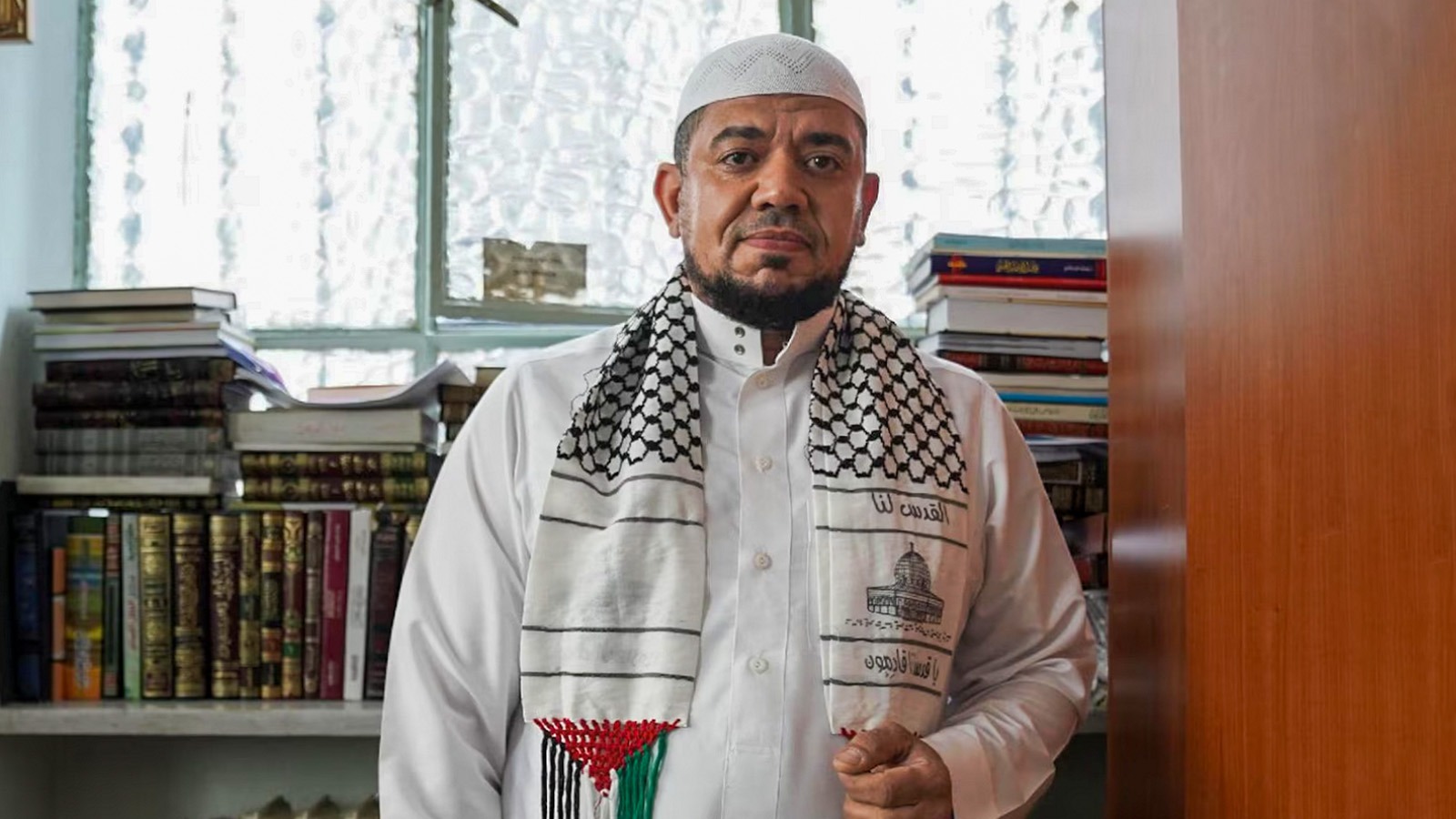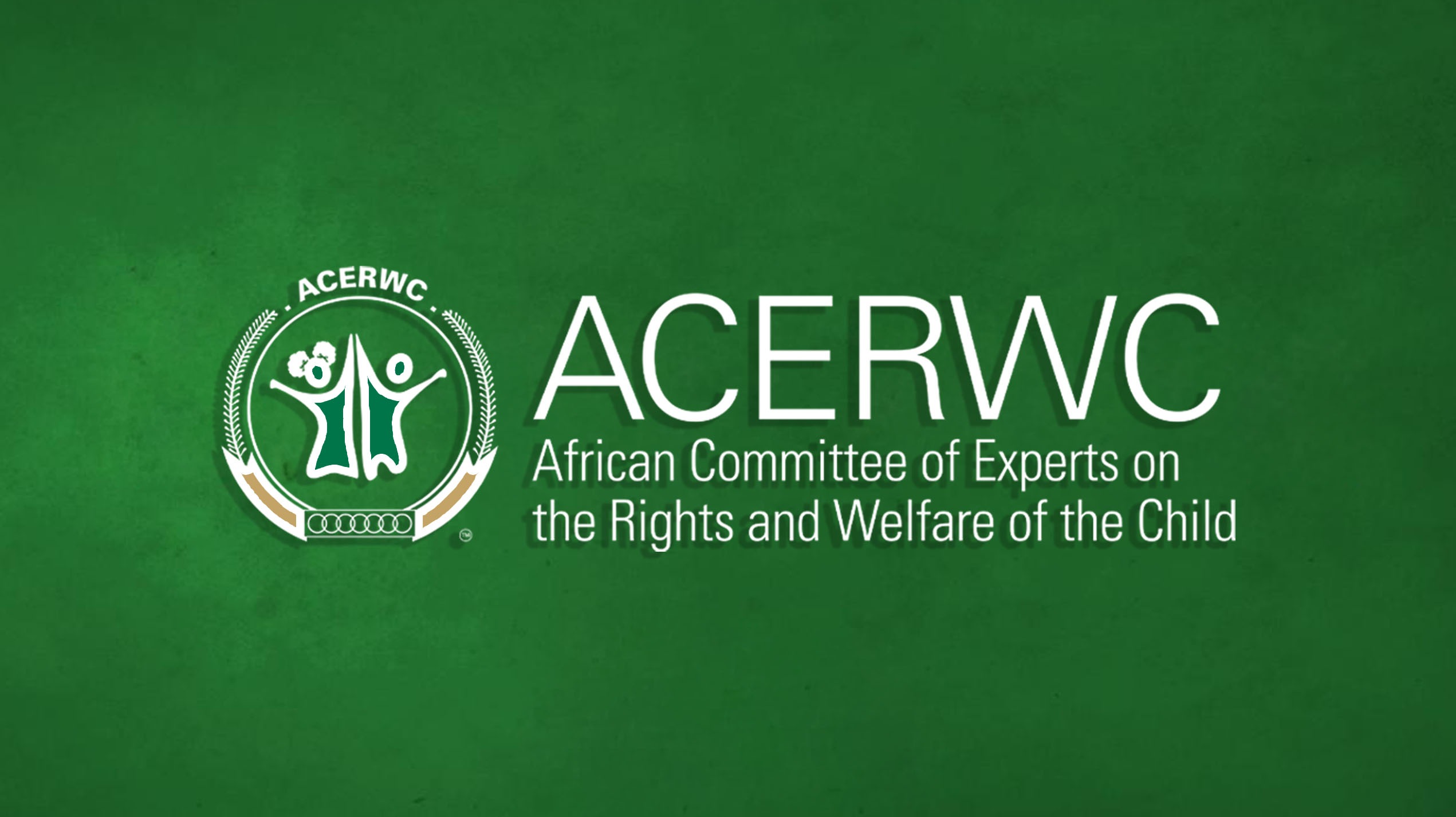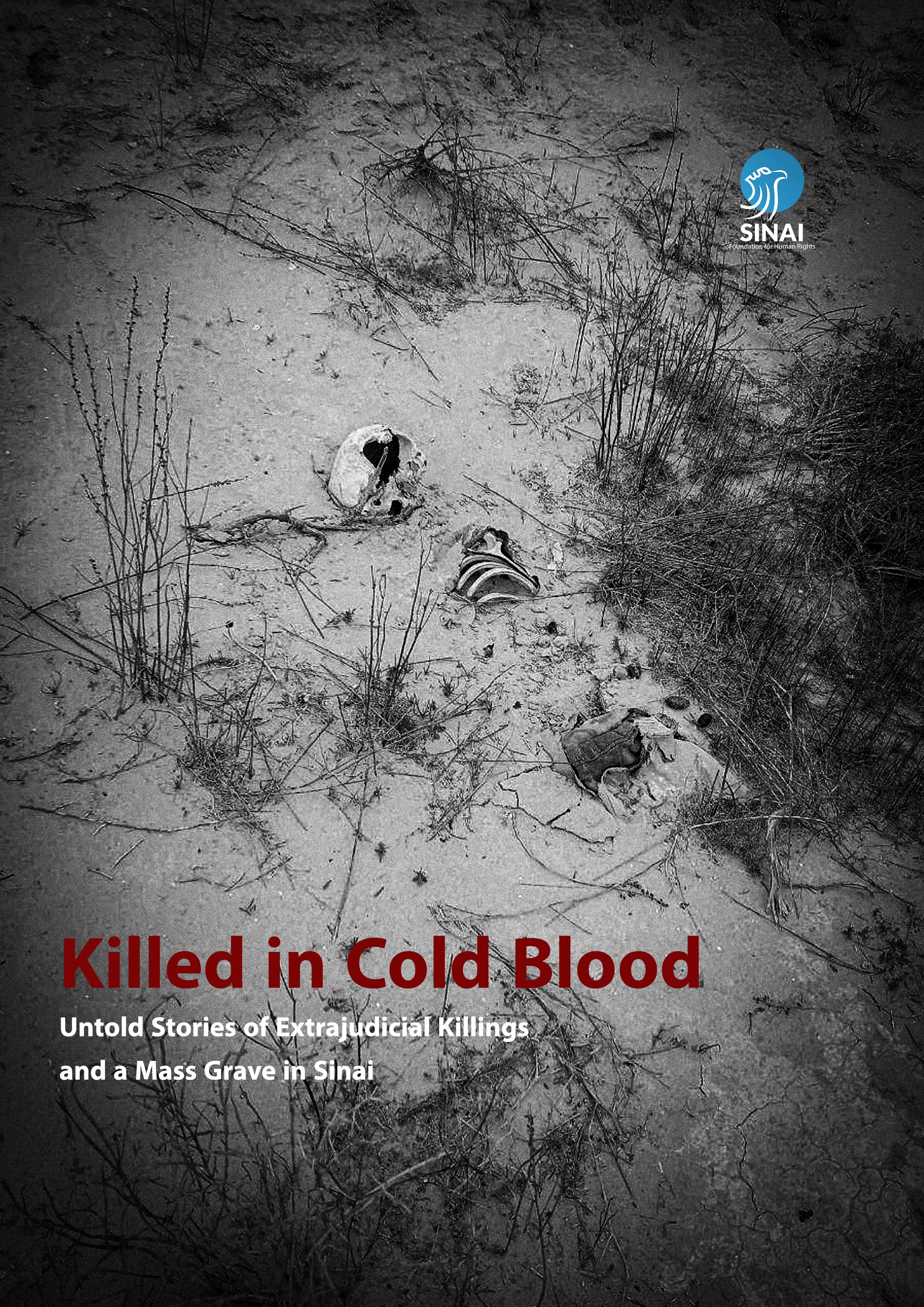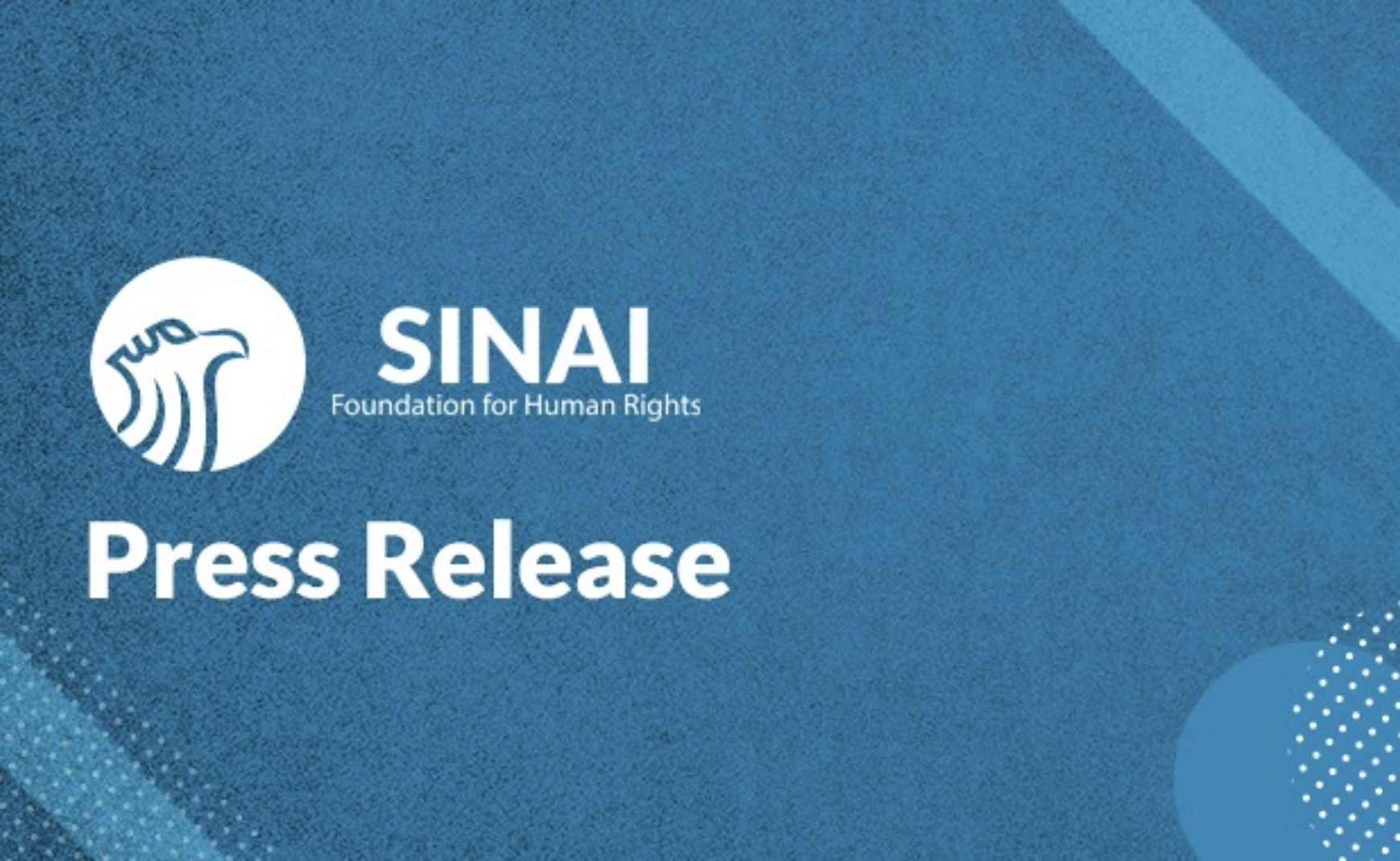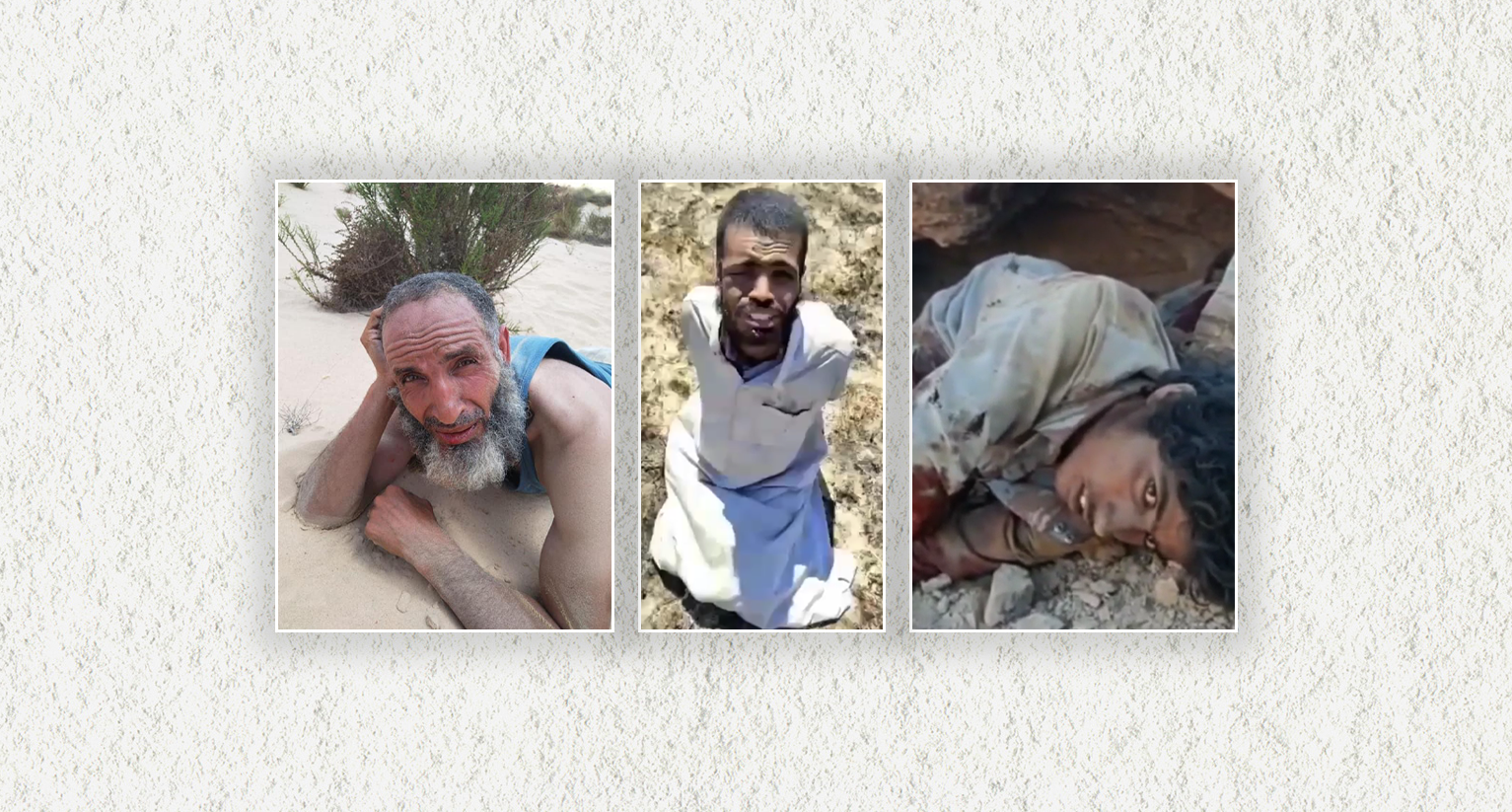
Again.. Videos show extrajudicial executions in Sinai by the military and its collaborators
(London - 20 August 2022) - The Sinai Foundation for Human Rights stated today that video clips and photographs showed militants of pro-military armed tribal groups in North Sinai executing three extrajudicial killings that separately took place in different areas of the governorate and all most likely took place in 2022 during current hostilities and sweeps against the last remaining strongholds of ISIS-affiliate Sinai Province group members.
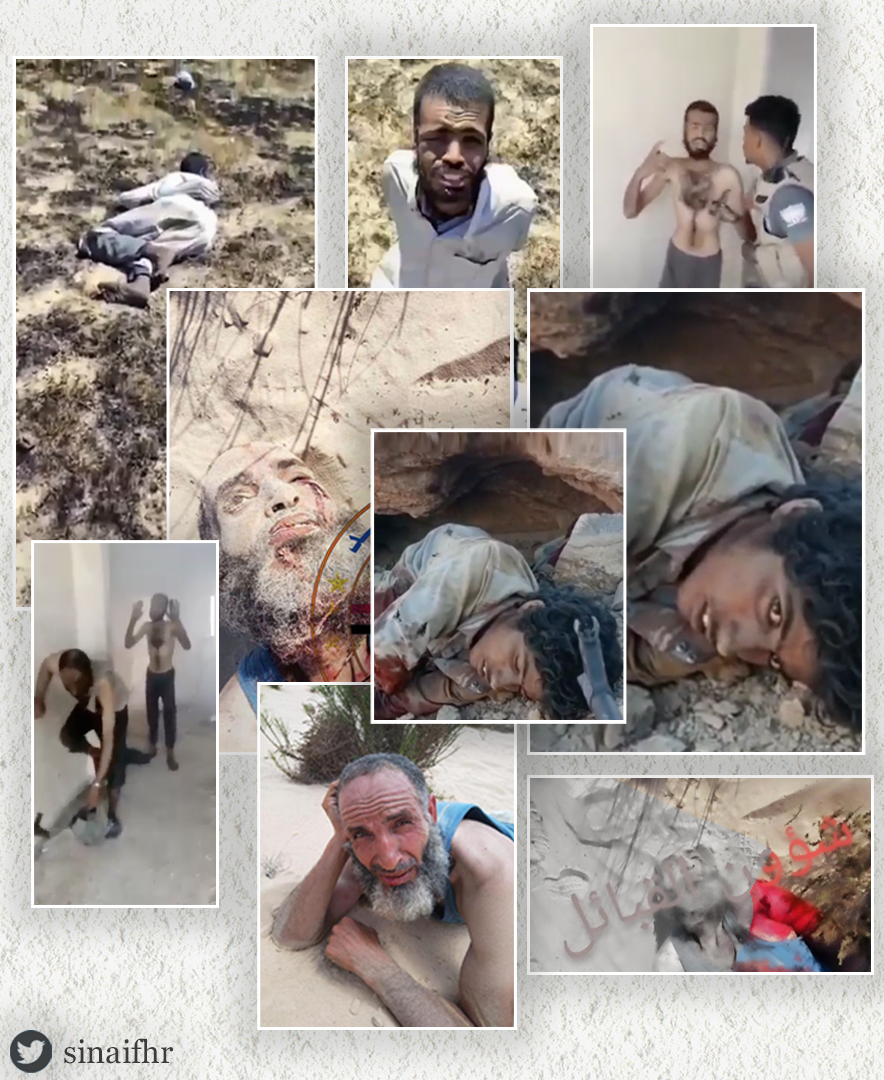
Analysis of the video and photographs and information acquired by the foundation show that it is absolutely apparent that those killed in the three incidents posed no threat to the life of government forces or pro-military armed tribal forces or others, or momentary danger to them that they could not avoid, on the contrary, two of the men were bound, and the third was injured and in a disturbed level of consciousness, and consequently, killing them was extrajudicial execution and a grave violation of the rules of the International Humanitarian Law, measuring up to a war crime. This resembles other similar executions documented by international and local organizations in North Sinai in previous years.
Ahmad Salem, the executive director of the Sinai Foundation for Human Rights, said:
“The ease with which members of the armed tribal groups and the Egyptian military in North Sinai brutally and extrajudicially execute those who were captured or injured shows that they fear no oversight or accountability for their actions. Under the guise of fighting terrorism, government forces and their supporting militias commit crimes of the same nature they are supposed to be fighting.
The video clips, which appeared between the beginning of July and the middle of August and were analyzed and used for documentation by the foundation, show close-range shootings - most likely by armed tribal men - at two unarmed individuals, one of whom was young and likely a child, and their immediate death. The two individuals’ identities were not known at once, but the one appearing to be a child is called Anas from “Tiaha” tribe, and he is shown in the video with a severed hand in what appears to be an injury from an explosive device. The other man was wearing a white garment and his hands were tied behind his back. It is apparent that the shooting and killing of the man and the child took place after they were - seemingly - apprehended by the tribal groups during the sweeping and raiding of areas of influence and operation of the “Sinai Province” group in North Sinai.
In a third separate video clip acquired by the foundation, tribal forces appear arguing with an ISIS member called “Abu-Tariq” while his hands are tied after he was apprehended, while photographs show the same man in the same clothes after he was killed.
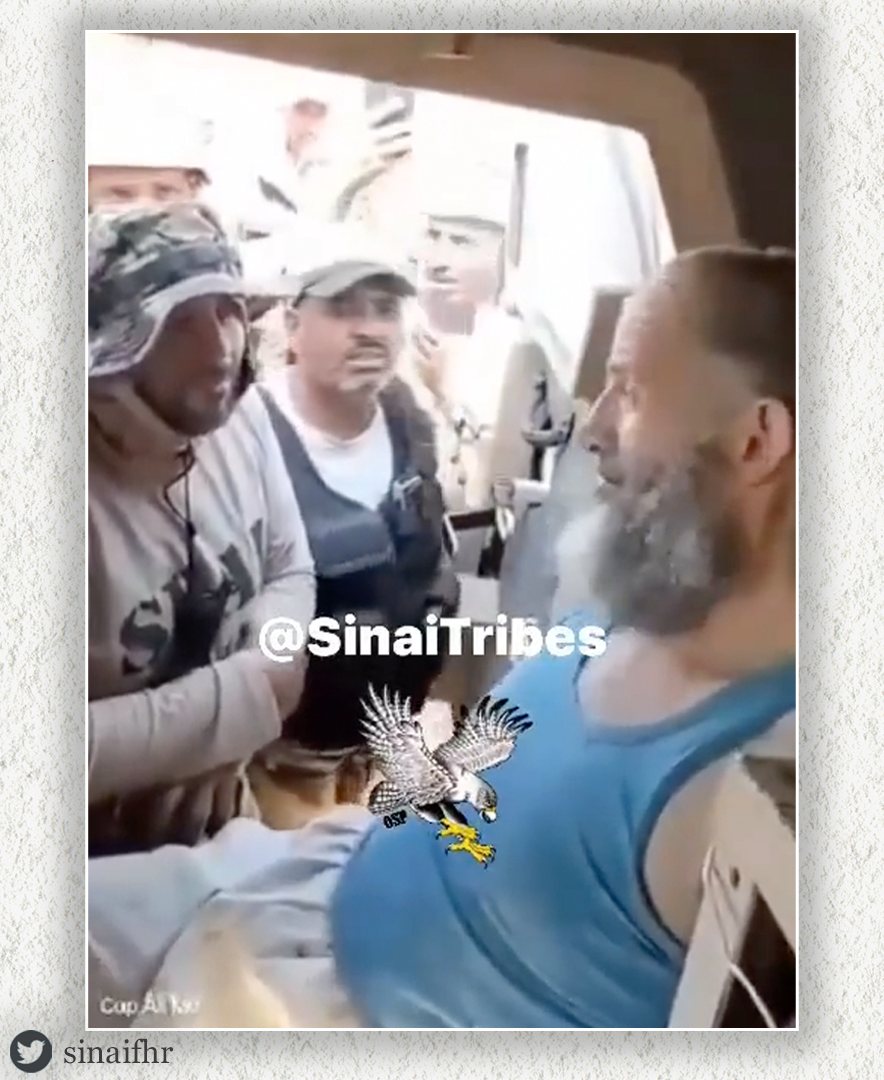
The Sinai Foundation for Human Rights said that in accordance with local and international laws, the Egyptian authorities must start an immediate independent and transparent investigation into those executions and all previous extrajudicial executions, and bring their perpetrators to fair trials. The authorities must also send clear unequivocal orders and instructions to all tribal groups whose arming and involvement in the hostilities in recent months were overseen by the Egyptian military, showing that armed involvement should take place according to the law and that violations are unacceptable, and their perpetrators will be held accountable. All apprehended men, women, and children who are suspected to be or are members of ISIS need to be handed over to the authorities for legal action to be taken against them.
Common article 3 of the Geneva Conventions that established the International Humanitarian Law, also known as the Laws of Armed Conflict prohibits “violence to life and person, in particular murder of all kinds” of civilians, combatants who put their weapons down, persons unable to fight, injured individuals, and combatants who are captured or imprisoned. All four of the Geneva Conventions categorize “willful killing” of protected persons as a grave breach. In this context, murder is a war crime, according to the International Criminal Court charter and several former war courts like the International Criminal Tribunal for the Former Yugoslavia. The African Charter on Human and Peoples’ Rights also prohibits the “arbitrary deprivation of the right to life”, and states that the right to life is an inherent right that is a non-derogable part of humanity that cannot be undermined even in times of war or war on terrorism.
The Egyptian authorities refuse to clearly admit that the military operations that intensified against ISIS militants in North Sinai amount to non-international war or armed conflict, and subsequently, the rules of the International Humanitarian Law apply to them. However, even in the case where the situation in Sinai is not an armed conflict, the International Human Rights Law more strictly emphasizes the right to life, and in this case, unlawful killings are considered extrajudicial executions, and in case they are strategized and widespread as part of a state policy, they could be considered crimes against humanity. An officially sponsored legal study stated that ISIS members are offered no legal protection and that Egyptian government forces are - subsequently - not bound by the rules and laws of armed conflict and war on terrorism.
The Egyptian Military Justice Law (law 25 for the year 1966), which is the law governing military mobilization and crimes in the sphere of military operations and the state of war, does not establish the rights of those who are captured clearly and in accordance with the Geneva Conventions. However, article 4 of the same law clearly states that it applies to war prisoners. Article 85 also states “field service” applies to “Members of a force at a time when that force is involved in combat operations against an enemy in or outside of the country.”, and that who is “considered the enemy are violators and armed gangs.” And article 137 states that “punished with imprisonment or a lighter punishment stated by this law is whoever directs violence towards an injured or sick soldier who cannot defend himself.”
Salem said:
The execution of apprehended and bound individuals who pose no threat to life shows a glimpse of the horrible crimes committed by military forces and militias supporting them in North Sinai. Despite the big media blackout, the few instants of abuse documented in Sinai in the past years give an idea of the absolute absence of the law and the prevalence of cruelty.
Following are details and analysis of the videos and photographs:
The Sinai Foundation for Human Rights researchers monitored all of those videos and photographs depicting the killings on social media pages and accounts officially representing the pro-military tribal groups in North Sinai, pages run by members of the armed tribal groups, or pages that support them and the military, in the context of those pages publishing news and pride in participating in the current armed operations, including celebrating and taking pride in the unlawful executions. The same pages have also taken pride in other violations, including publishing several photos showing the recruitment, death, and participation of armed children in hostilities to support the military. The foundation also acquired one of those clips (depicting the murder of the child) and a photo of one of the murdered men exclusively from a source from within the tribal groups.
The first incident: The execution of an elderly member of ISIS after he was captured alive
The sequence of a video and three photographs shows the execution of a man called “Abu-Tariq” who was captured alive likely in a desert area south of Bir al-Abd, according to an interview we conducted with a private source who is a member of a tribal group operating in the area in western Sinai. The information we acquired from the source aligns with the nature of the soil, sand dunes, and vegetation seen in the video and photos, as the plant a’adir or a’athir, the local names for a wild plant scientifically known as Artemisia Monosperma, that widely grows in areas of Bir al-Abd, can be seen. The plant also appears almost dry, which coincides with the date of publication of the video, as the a’adir starts drying up in June and July during its seasonal cycle.
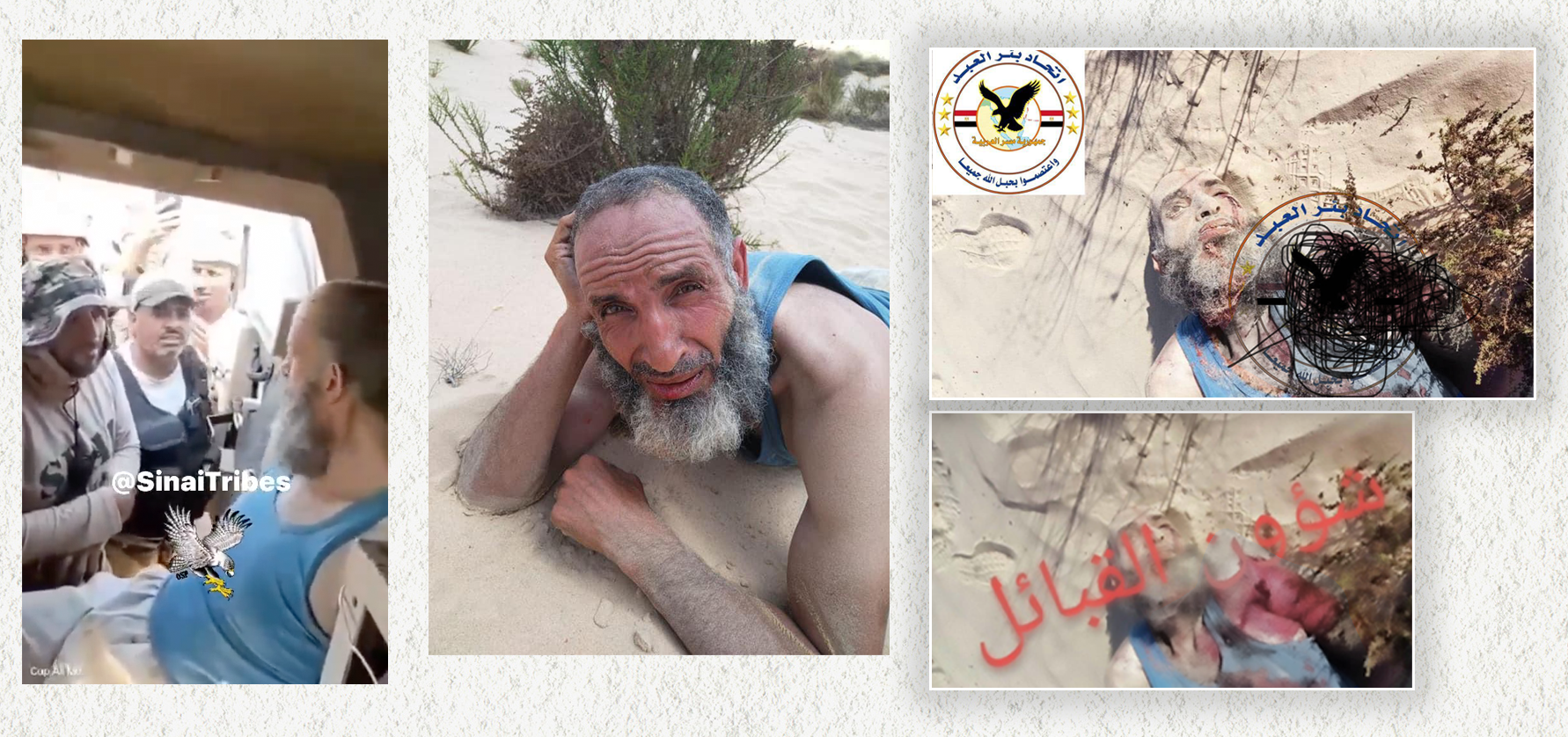
The beginning was from a video published by the official account for the Sinai tribal union on 2 July 2022, which is the media platform of one of the most prominent pro-military armed tribal groups, most of whose members are part of the Tarabin tribe (the video was deleted about an hour after its upload). The video showed a conversation between who the papers said was “Abu-Tariq”, that appears to be an elderly man with a large beard who is an ISIS member, wearing a light blue undershirt, talking to several members of the pro-military armed tribal groups from inside a military vehicle with his hands tied behind his back. The Sinai Foundation for Human Rights found out from an expert that that vehicle was “Tiger” model.
The 45-second video shows the man sitting in this position talking about what he called “the battle between right and wrong”, not appearing nervous, while no less than 7 members of the pro-military armed tribal groups or the military, including one man wearing a bulletproof vest and at least three others wearing military helmets, standing outside the vehicle, and some of them are holding cellphones filming the conversation, while others made fun of the bound man’s speech.
Another photo acquired by the foundation from private sources show the same man before his execution, lying on his side in a sand area near a small tree, appearing unwell.
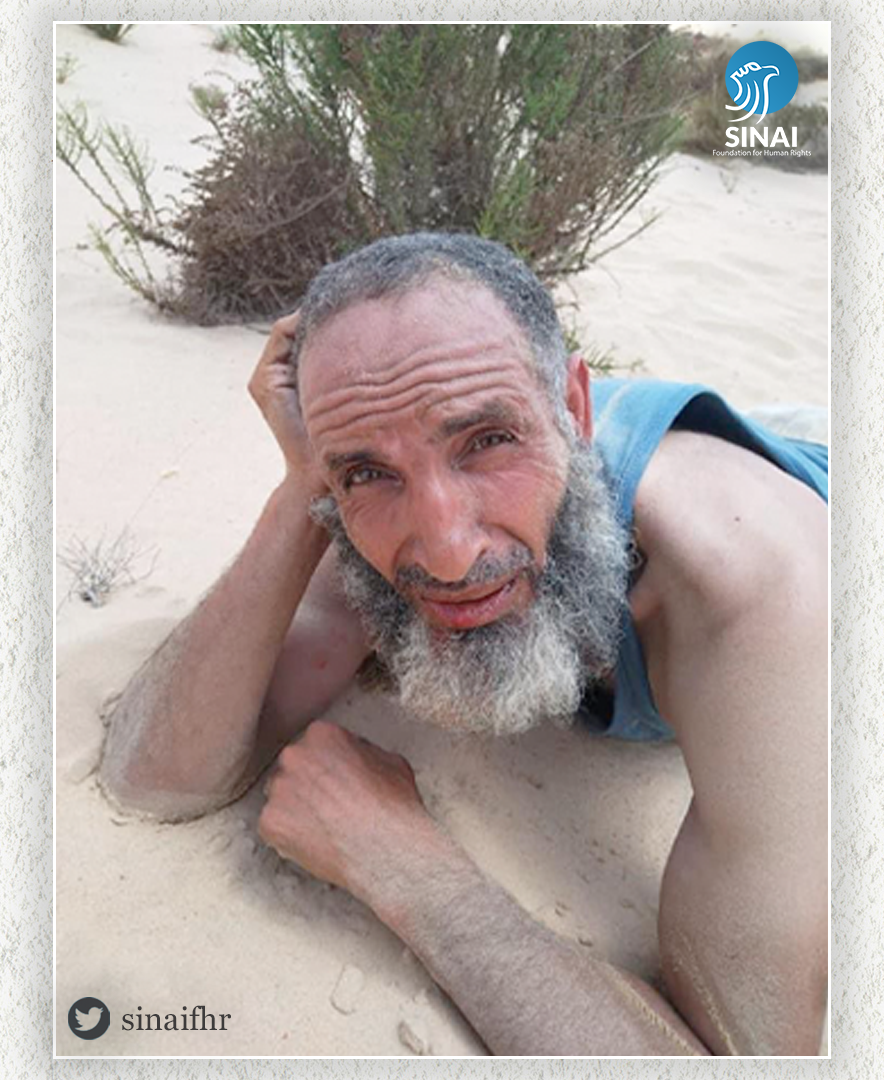
About 3 hours after publishing the video, the Official Bir al-Abd Union Facebook page, which is considered an official page for one of the pro-military armed tribal groups in Bir al-Abd, whose members are part of the Dawaghra, Baiadia, and Akharsa tribes inhabiting the center of Bir al-Abd, published a photo of the same man who was talking in the video, dead. The photo shows the man lying on his back in a sand area, with blood covering his chest, clothes, face, and eyes. He appears to be lying next to the same plants shown in the first photo, wearing the same undershirt he wore in the video.
Afterwards, a Facebook page named Official Tribal Affairs, which is another group of pro-military tribal militants working under the supervision of the military intelligence’s tribal affairs office, shared what appears to be the same photograph of the man, dead and covered in his own blood.
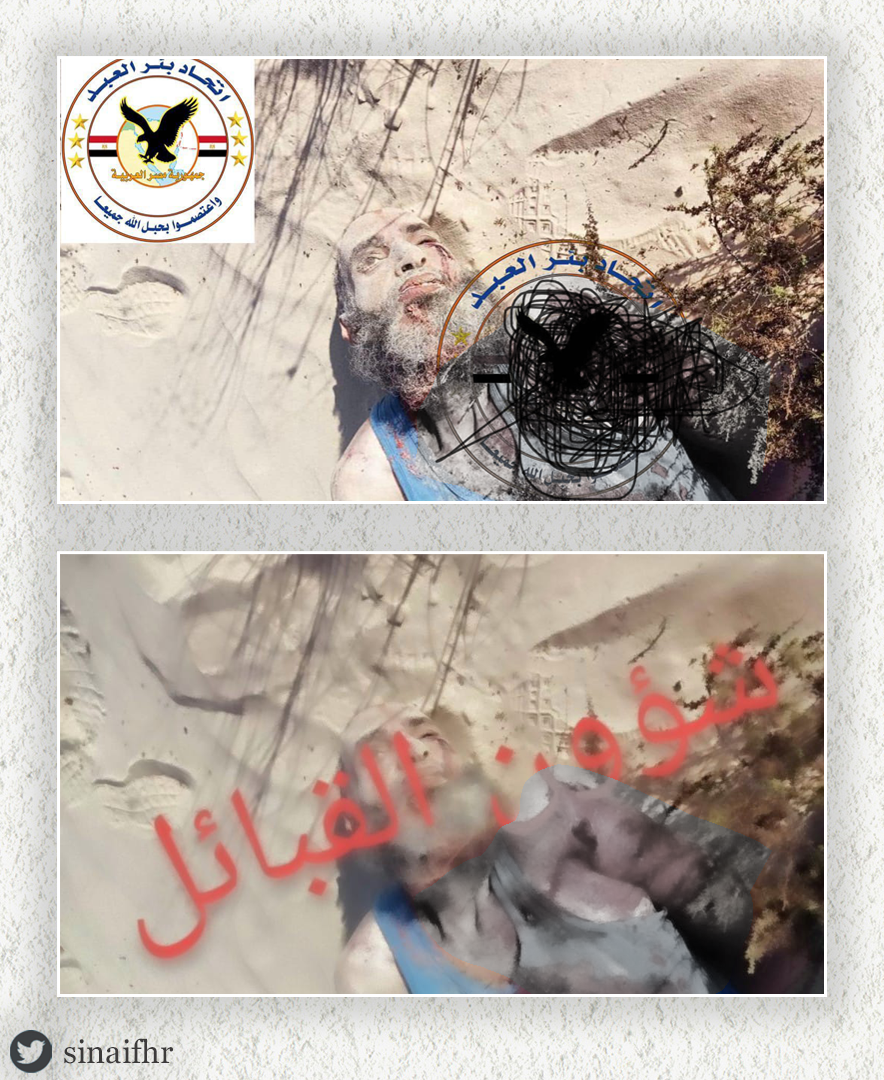
In both cases, the two pages shared the photo of the deceased with each group’s “logo”, meaning that the two pages representing two different groups had the same access to the original photograph from its source.
According to an Egyptian military affairs expert the foundation spoke with, the United Arab Emirates is the main supplier of Tiger model military vehicles to Egypt. The UAE manufactures the vehicles in cooperation with the Czech company VOP CZ.
The second incident: Extrajudicial execution of a child with a severed hand
A Facebook page called “Al-Marih Anews” which supports the military and shares news of tribal operations in Sinai (it seemingly is connected to a village in Bir al-Abd with the same name: Marih), on 17 August 2022, at 1:33 PM, shared am 18-second video described as “elemenation of a takfiri”, without mentioning the place or date the footage was taken. The Sinai Foundation acquired through a private source from one of the armed tribal groups a clear version of the video without the sound effects added to the one on the page. The same source told the foundation that this video was circulated on 16 August through a WhatsApp group private to the members of one of the pro-military armed tribal groups, where the militants exchange news and clips of their operations as a way to share “accomplishments.” The source also said that the murder of the child took place in Maghara area in Hasana, central Sinai, and this coincides with the topography of the area appearing in the video, as the child is shown lying on what appears to be rocky ground, and what looks like a small cave or a cleft in a rock can be seen in the background, and this topography marks the area of Maghara and areas of central Sinai in general, and there is no such nature in Rafah, Sheikh Zuwayed, Arish, or Bir al-Abd, which are generally flat.
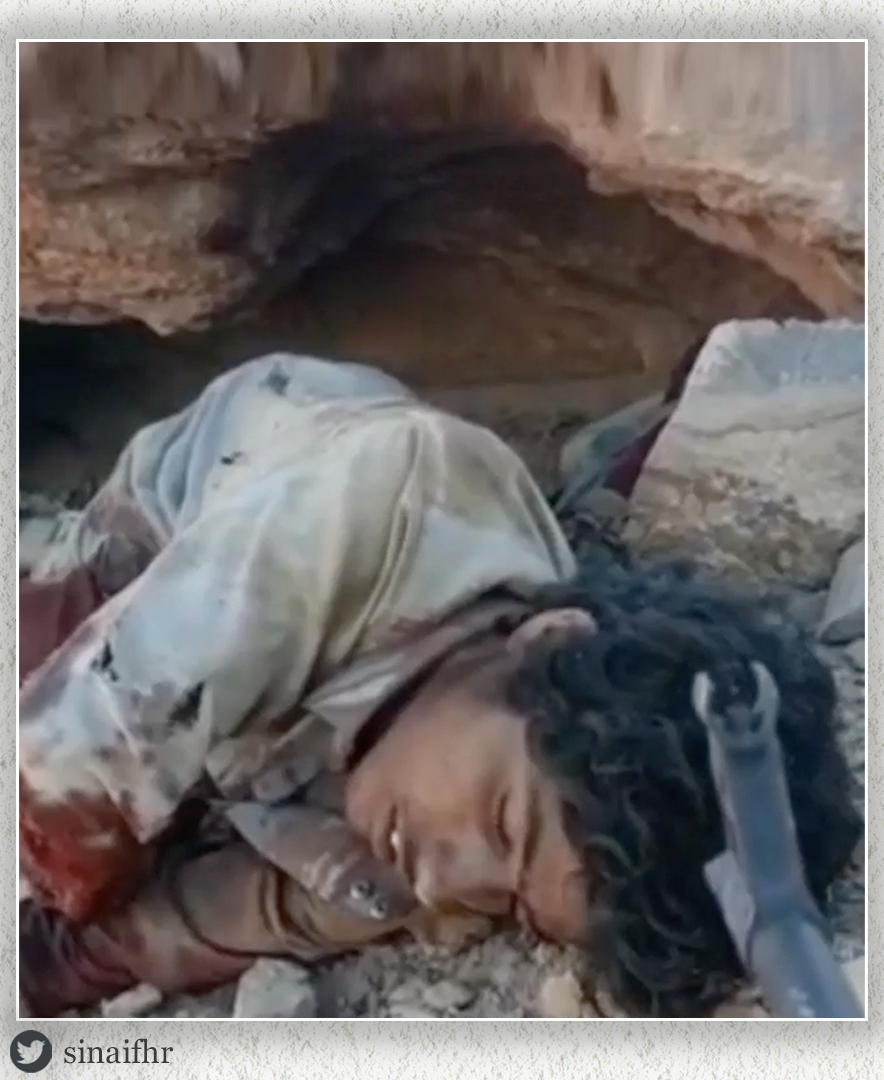
The video shows the child lying on the ground, seemingly injured from an explosion that severed his hand from above the elbow, looking very ill and consciously disturbed, and his clothes covered in blood. In the video, a man whose face cannot be seen points a machine gun at the child while asking him questions. The child answers the armed man’s question about his name saying that his name is Anas and that he is part of the Tiaha tribe. Afterwards, the man shoots the child in the head at point blank, where the barrel of the gun was no more than 30 centimeters away.
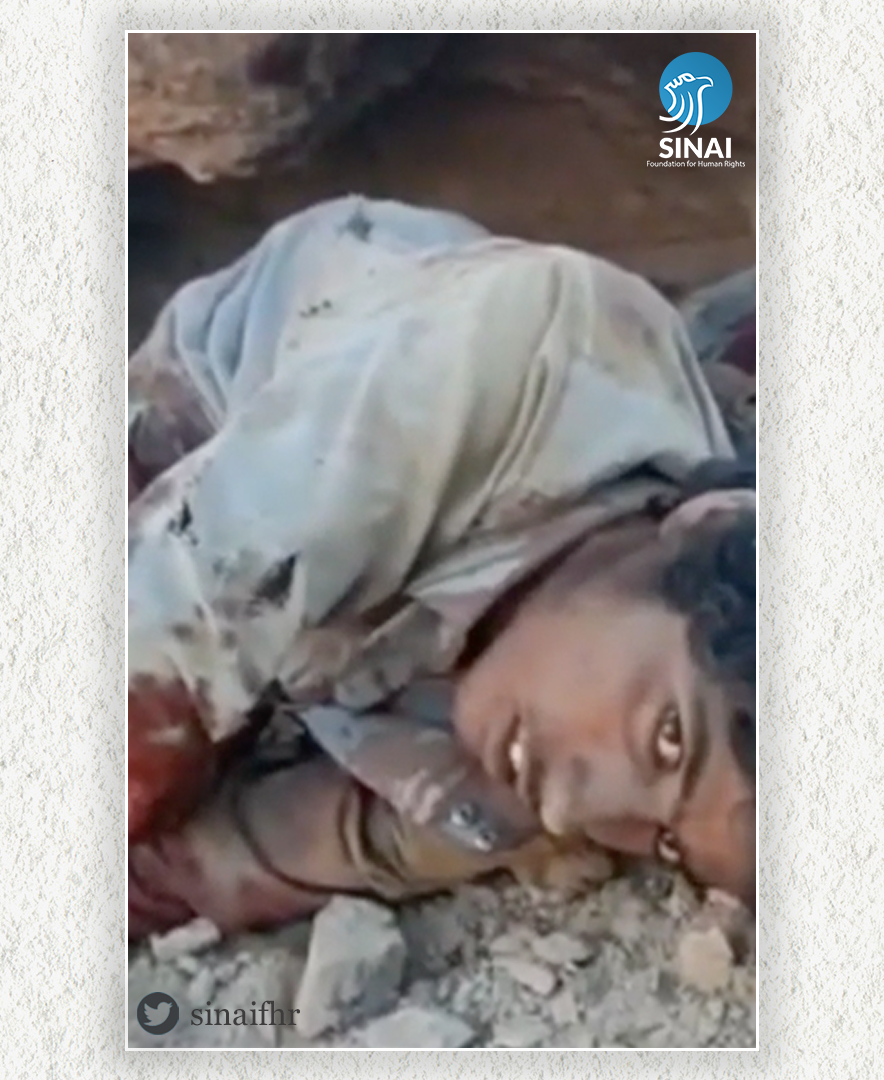
The armed man in the video speaks in a non-Bedouin Egyptian dialect, and in the video, voices of other men around him could be heard calling him “basha”, and this all points to him being a military officer. In the end of the video, it quickly appears that the man is wearing military pants and shoes.
Directly before the shooting, one of the man’s companions said: “come on, basha, come on.” And after the child was killed, the man orders his companions: “evacuate the area at once”, then he calls “weapon, weapon, weapon!” Then the same voice that had said “come on, basha, come on” repeats the importance of confiscating the weapon that was perhaps at the incident site with the child.
The third incident: The execution of a bound man in a desert area
The same Facebook page “Al-Marih Anews” published a video on 19 August at 9:54 AM titled “Victory is near Insha’Allah” without revealing the place or time of the incident. The video shows a man with his hands tied behind his back, wearing a white garment and a dark pair of brown or grey pants, asking for mercy from others around him not shown in the video. He was saying in a Sinai dialect: “Guys, have mercy on me because you are merciful. Merciful god, have mercy on me. No no..” Someone orders him: “Look the other way” before he was heavily shot at by those surrounding him.
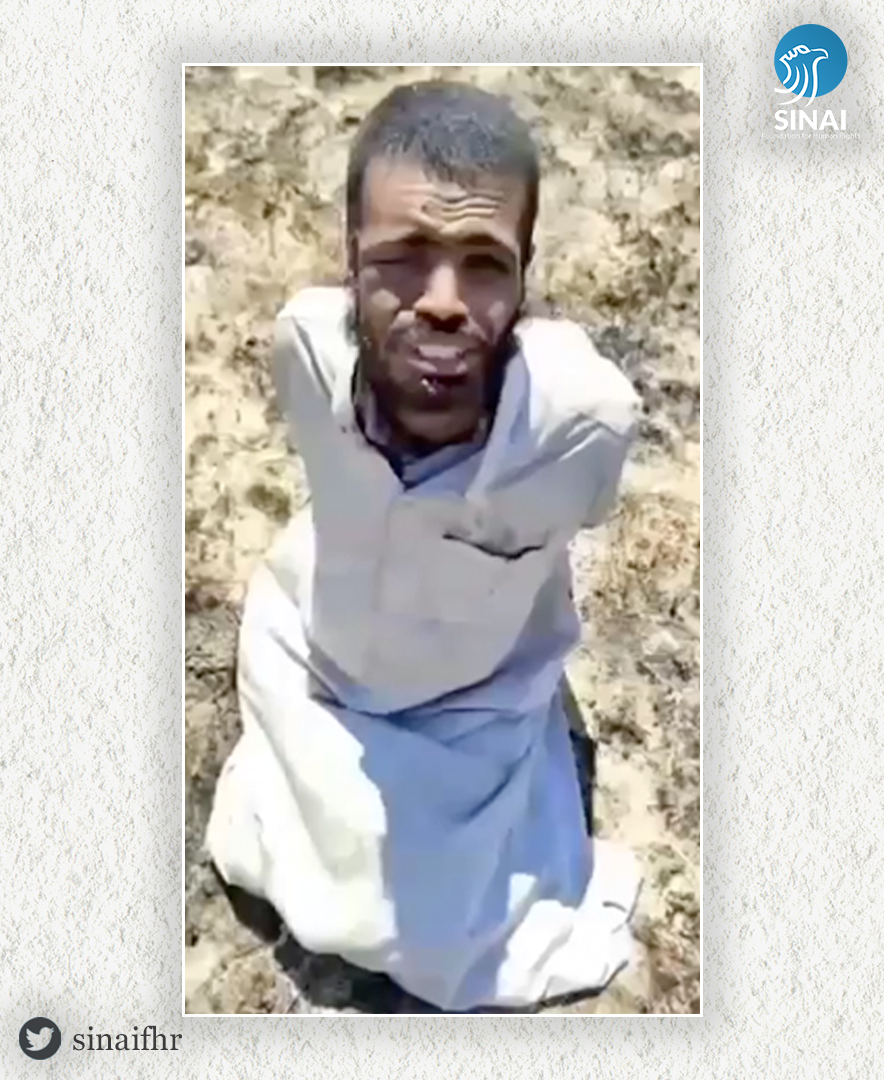
Afterwards, the man’s bound body lies face down in an unnatural position after he was sitting, and one of his feet seems to be involuntarily moving. A voice in the video then says: “He is not done. He is not done” (meaning he is not yet dead), then the man is shot at again and a voice says: “untie his hands.”
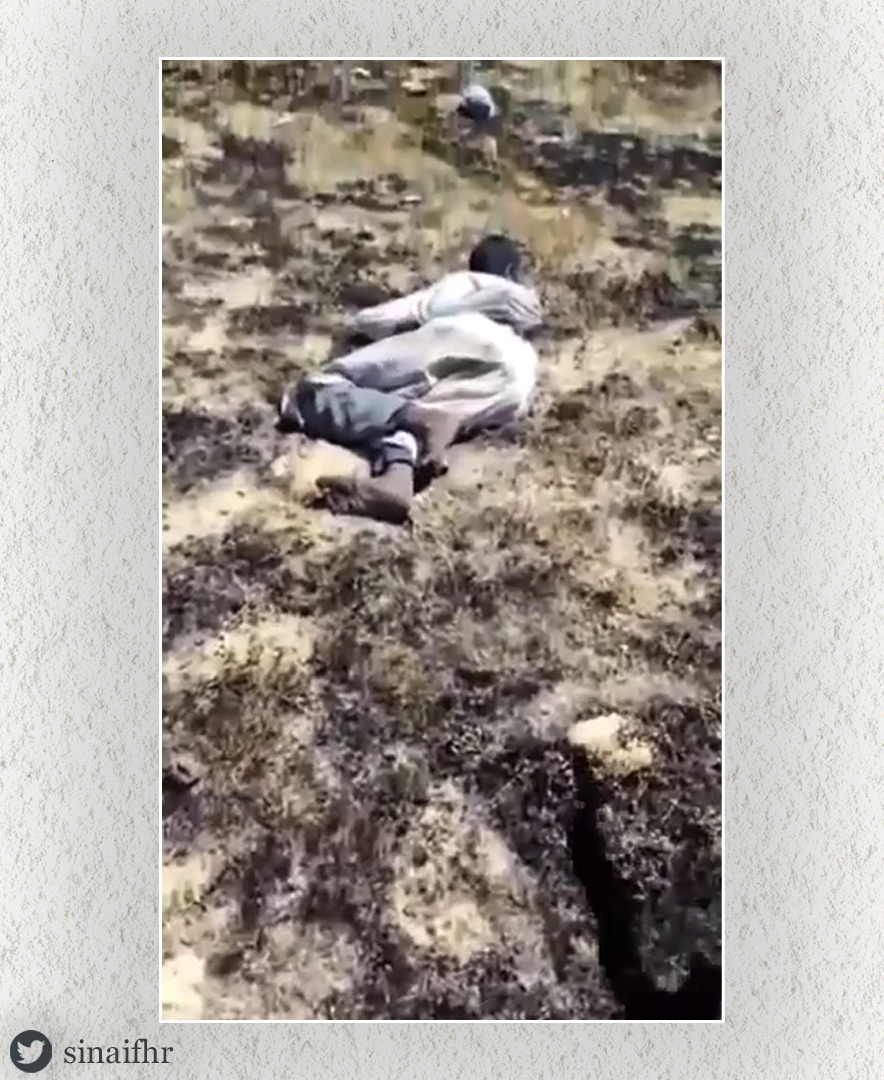
In the two incidents, the one with the child and the one with the man in the white garment, another page called “Shibana Today” shared the same two clips in a long video that included photos and clips of military operations in which tribal groups participated with military forces on 19 August, before the whole video was deleted on the same day or one day later. (link of the deleted video)
The foundation’s researchers also managed through monitoring and analyzing several photographs published in pro-military pages run by the tribes to find another video shared by a personal account belonging to a member of the armed tribal groups on 12 July 2022 showing the moment of surrender of two men in a house in North Sinai during a raid where the armed tribal men, seemingly part of Rumailat tribe, and military soldiers appear. The raid seems to have taken place in western Rafah. The videos show that one of the men is the same man who was killed in the video shared later, as he has the same facial features and body shape, and appears to be wearing pants of the same dark color.
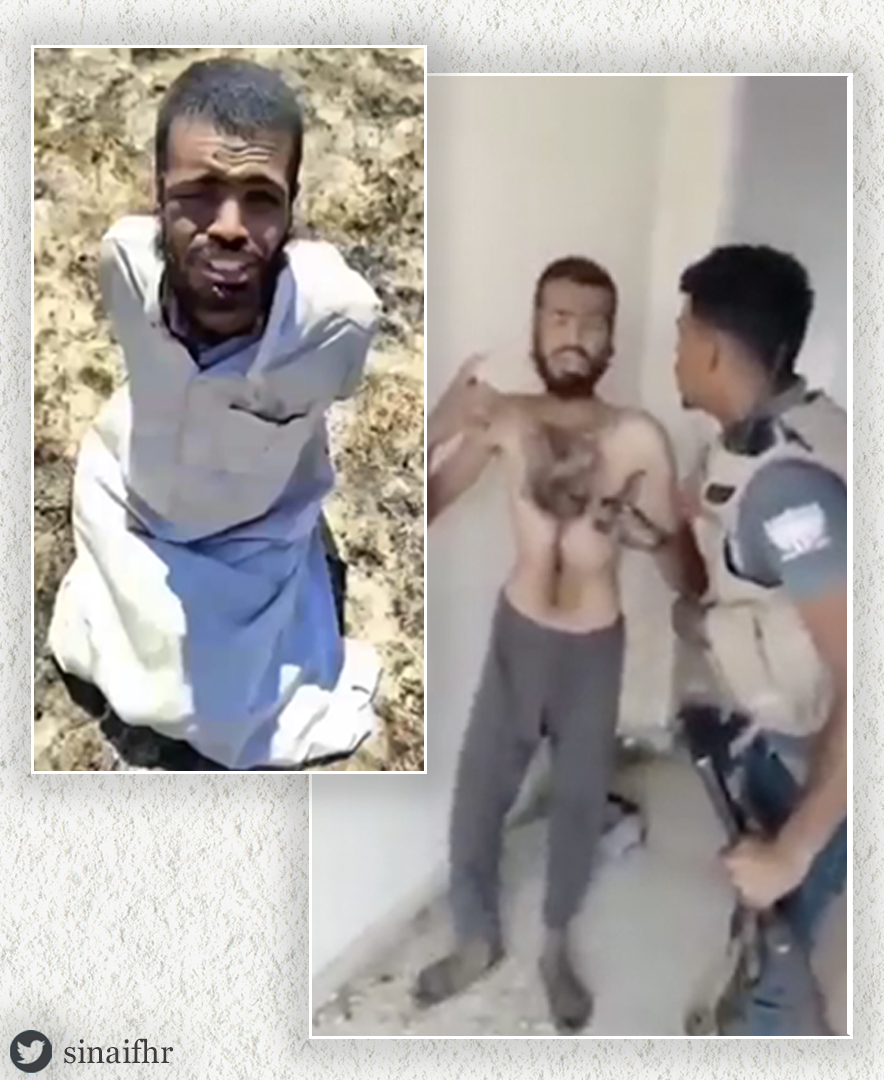
Background
It has been rare for independent observers or journalists to be allowed to investigate the armed conflict in the Sinai Peninsula since the end of 2013, as the government treats the area as a closed-off military zone, as a curfew and state of emergency were imposed there since October 2014 till late 2021. Egyptian journalists who covered the news of North Sinai were prosecuted, like what happened with the researcher Ismail Iskandarani who was sentenced to 10 years in prison after being charged with spreading false news following his arrest on 29 November 2015.
Several local and international human rights organizations have previously documented Ministry of Interior and military forces executing extrajudicial executions. One of those instances was when Human Rights Watch issued a statement on 16 March 2017 accusing the Egyptian Ministry of Interior of extrajudicially executing 6 to 10 men in a house in Arish, North Sinai, and fabricating a video raiding a house to cover for the murder. Amnesty International also issued a statement on 21 April 2017 accusing the Egyptian military of being responsible for at least seven unlawful killings, including shooting an unarmed man and a 17-year-old child at point-blank, killing them both.
Since the escalation of the conflict in Sinai by the end of 2013, the military started utilizing local groups and militias in facing armed militants, to counter the military’s decades-long weakness in information and knowledge of operations in the area. They recruited a number of locals as part of irregular forces that are not subject to current laws called by the authorities “Manadeeb” (delegates), and their task is to provide intelligence, in addition to participating in sweeps and arrests of local citizens. They can be differentiated from regular forces by their clothes, which are a mix between military and civilian clothes. Their actions led to humanitarian violations and exploitation of the power given to them for personal gain and settling personal scores.
An attempt to form an armed group of tribal members to fight the group started in mid-2015 after an attack by the Sinai Province group on the Barth village market in Southern Rafah where Tarabin tribe live. The “Sinai Tribal Union”, most of whose members were part of Tarabin tribe, was formed. The group also executed a suicide attack on a checkpoint established by Tarabin tribe near Rafah in April 2017. In May 2017, the Tarabin tribe, one of the largest tribes in Sinai, declared “war” on the Sinai Province group in a press statement. This statement was followed by another from Sawarka tribe announcing readiness to get into armed clashes with the group in Sinai. Military and intelligence authorities had reservations on the military directly and uniformly arming and training these groups. Despite the tribal members’ cooperation with security and military forces preceding these escalations, since 2013, their role had not reached regular involvement in armed clashes against the group. In July 2015, before the tribes reached the point of armed clashes with the Sinai Province group, one of the tribal elders was reported to have said: “The number of Bedouins working with the military as companions in military campaigns is up to 300.”
Despite the military authorities’ reservations on widely arming the tribal members, according to the Sinai Foundation for Human Rights monitoring of the escalation of the situation, a gradual noticeable change happened in the authorities’ beliefs since July 2020 after the group’s attack on a military camp in Rabea village in Bir al-Abd, which according to media reports led to the death of 40 and injury of 60 other military personnel, followed by a wide spread of ISIS militants in Bir al-Abd villages, seizing control of them, and targeting local civilians they accused of working with security forces, which led many inhabitants to move from the area. The security deterioration in the area led to the military adopting a new approach that depends on hastily integrating members of tribes and the community into military operations, as members of Biadia, Sama’ana, Dawaghra, and Akharsa tribes in western Sinai were armed to defend their villages against the group’s attacks, and to secure the displaced persons’ return.
It is worth mentioning that this change in the tribal groups’ duties also meant that the military regularly trained those groups in military camps and allowed them to coordinate operations and aerial support as part of military and security operations. The bigger leap, however, appeared in the end of 2021 after a request was made from military intelligence, specifically the tribal affairs office, to elders of Sawarka, Tarabin, and Rumailat tribes to form armed groups from the tribes who were funded by business men from the tribes and were trained in military bases in Arish and Bir al-Abd, in what the combatants of those tribes called “the purging battle.” Since then, and especially spring of 2022, those tribal groups have been executing daily or semi-daily military operations on what remains of the group’s strongholds, whose ability to execute attacks has notably subsided. Additionally, since then, social media pages that represent these tribal groups and share news on the development of their field combats have also remarkably increased.
Tags
Related Postes
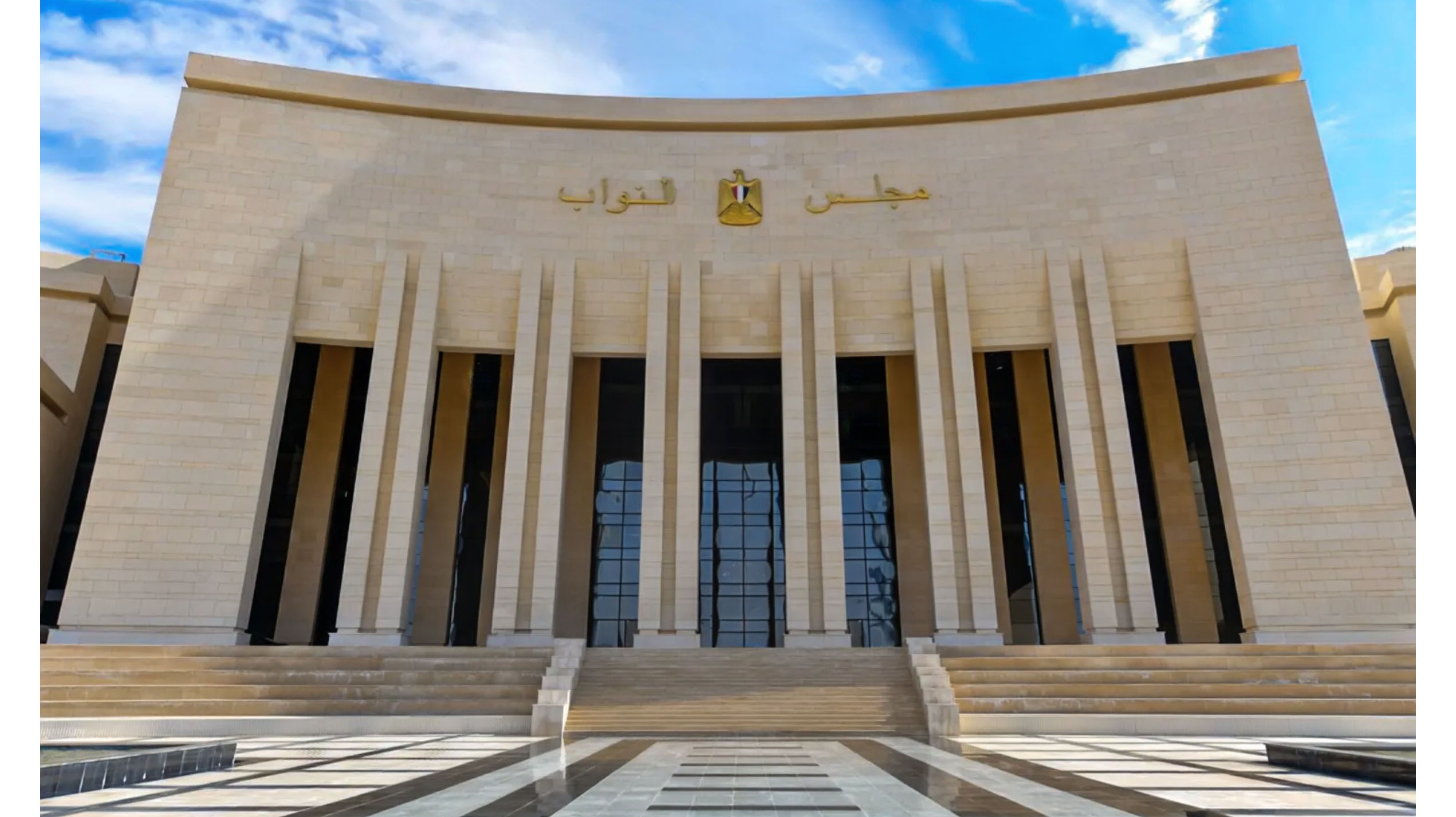 English content
English content

